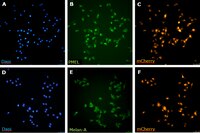SCC465 Sigma-AldrichBT-RMS Brain-tropic RET Melanoma-sorted Mouse Cell Line
SCC465, the BT-RMS brain-tropic RET melanoma-sorted mouse cell line, expresses mCherry and exhibits increased incidence and shortened timeline of brain metastasis post-subdermal injection.
More>> SCC465, the BT-RMS brain-tropic RET melanoma-sorted mouse cell line, expresses mCherry and exhibits increased incidence and shortened timeline of brain metastasis post-subdermal injection. Less<<Recommended Products
Overview
| Replacement Information |
|---|
| References |
|---|
| Product Information | |
|---|---|
| Components |
|
| Quality Level | MQ100 |
| Biological Information | |
|---|---|
| Host | Mouse |
| Cell Line Type |
|
| Physicochemical Information |
|---|
| Dimensions |
|---|
| Materials Information |
|---|
| Toxicological Information |
|---|
| Safety Information according to GHS |
|---|
| Safety Information |
|---|
| Product Usage Statements | |
|---|---|
| Quality Assurance | • Each vial contains ≥1X10⁶ viable cells. • BT-RMS cells are verified to be of mouse origin and negative for human, rat, Chinese hamster, Golden Syrian hamster, and non-human primate interspecies contamination, as assessed by a Contamination Clear panel by Charles River Animal Diagnostic Services • Cells tested negative for infectious diseases against a Mouse Essential CLEAR panel by Charles River Animal Diagnostic Services. • Cells tested negative for mycoplasma. |
| Usage Statement |
|
| Packaging Information | |
|---|---|
| Material Size | Pack Size >1x10^6 viable cells/vial |
| Transport Information |
|---|
| Supplemental Information |
|---|
| Specifications |
|---|
| Global Trade Item Number | |
|---|---|
| Catalogue Number | GTIN |
| SCC465 | 04065270302175 |
Documentation
Data Sheet
| Title |
|---|
| Data_sheet-SCC465 |











